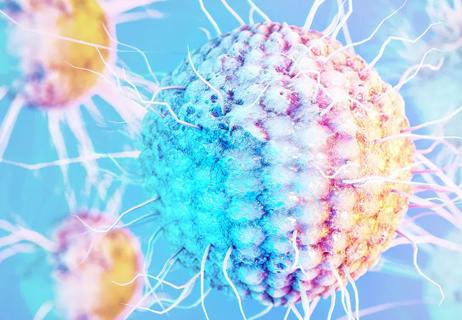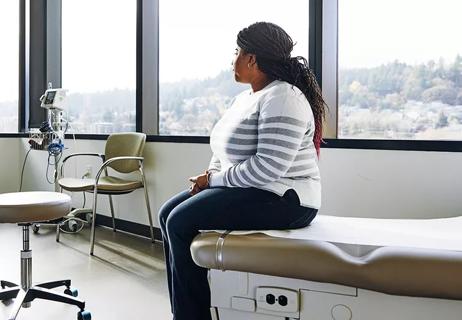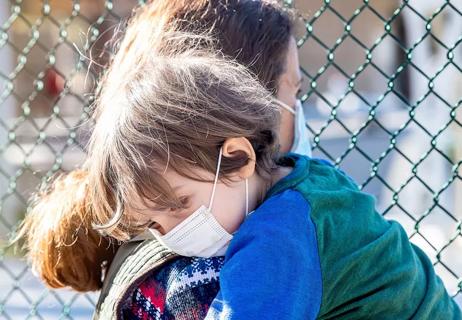Carcinomas are the most common and affect skin and organs

If you or someone you know has been diagnosed with cancer, you may remember the conversation sounding a bit like Charlie Brown’s teacher. Anything that’s said after the word “cancer” can sound a lot like a jumbled wah-wah-wah.
Advertisement
Cleveland Clinic is a non-profit academic medical center. Advertising on our site helps support our mission. We do not endorse non-Cleveland Clinic products or services. Policy
Your head is spinning with too much and too little information all at once. And when medical terms start getting tossed around, it’s easy to get confused. Especially when the words sound similar.
Two kinds of cancer in particular can easily be misunderstood but are actually quite different: carcinoma and sarcoma.
We talked with oncologist Dale Shepard, MD, PhD, to explain the similarities and differences between these two kinds of cancer.
Carcinoma and sarcoma are two of the five main types of cancer.
Carcinomas are the kind you hear about the most. When people say they have skin cancer, prostate cancer, breast cancer, lung cancer and so on, those are all carcinomas.
Sarcomas, on the other hand, are much rarer. They’re cancers that form in bones and soft tissue, like in fat, muscle, nerves and ligaments.
Other main types of cancer include:
| Type of cancer | Where does it develop? | Rarity |
|---|---|---|
| Carcinoma | Cells that line the surfaces in and out of your body, like skin and other organs. | Common: 80% of all cancer diagnoses. |
| Sarcoma | Bones, nerves, soft tissue and connective tissue, like muscle, fat, blood vessels, cartilage and ligaments. | Rare: 1% of adult cancer diagnoses and15% of childhood cancer diagnoses. |
| Type of cancer | ||
| Carcinoma | ||
| Where does it develop? | ||
| Cells that line the surfaces in and out of your body, like skin and other organs. | ||
| Rarity | ||
| Common: 80% of all cancer diagnoses. | ||
| Sarcoma | ||
| Where does it develop? | ||
| Bones, nerves, soft tissue and connective tissue, like muscle, fat, blood vessels, cartilage and ligaments. | ||
| Rarity | ||
| Rare: 1% of adult cancer diagnoses and15% of childhood cancer diagnoses. |
Carcinomas are cancers that develop in your epithelial cells. Those are the cells at the outermost layer of the surfaces inside and outside your body. They’re the cells that surround your skin, as well as your organs and glands.
Advertisement
“Carcinomas are the most common type of cancer. They’re the ones most people immediately think of,” Dr. Shepard says.
That’s because 80% of cancer diagnoses are carcinomas.
Common types of carcinomas include:
Your genetics and certain lifestyle factors can increase your risk of developing carcinoma. That includes things like:
Sarcomas are cancers that originate in your mesenchymal cells. Those are the cells that make up bones and soft tissues, like muscle, blood vessels, fat and more.
Sarcomas tend to start in your appendages, like your legs, feet, shoulders, arms and hands. They can also originate on your abdomen or neck.
There are more than 70 kinds of sarcoma.
After being characterized by where they begin, sarcomas have specific names based on their cellular makeup (how they look under a microscope). For example, distal type sarcoma is a kind of epithelioid (deep skin tissue) sarcoma. And Ewing sarcoma is a type of osteosarcoma (bone cancer).
Sarcomas are a very rare form of cancer. They account for just 1% of adult cancer diagnoses each year and 15% of children’s cancer diagnoses. Bone sarcomas are more likely to affect children, teens and adults over the age of 65. Soft tissue sarcomas are more common in adults than children.
Unlike carcinomas, scientists haven’t definitively connected sarcomas to lifestyle factors like smoking or sun exposure. Risk factors for sarcoma include:
Advertisement
When you hear the words “tumor” or anything ending in “-oma” it can be easy to jump to conclusions and think you’re talking about cancer. But that’s not always the case.
Cancerous tumors, including carcinoma and sarcoma, are also called “malignant” tumors. In malignant tumors, cells divide uncontrollably. They invade nearby tissues. And they can eventually spread to distant sites.
But not all tumors are cancerous. Noncancerous tumors are called “benign.” And benign tumors don’t spread.
“Benign masses may also end in ‘-oma,’ which means ‘tumor,’” Dr. Shepard explains. “But these cells behave — and are treated — quite differently from malignant tumors.”
Benign tumors include adenomas, fibromas and angiomas. Those won’t invade nearby tissues or spread to other sites. But they can sound awfully similar to their malignant counterparts: “adenocarcinoma,” “fibrosarcoma” and “angiosarcoma.”
When cancer spreads from one part of your body to another it’s called a “metastasis.”
Carcinomas and sarcomas generally spread in the same way: Either through your bloodstream or your lymphatic system. Metastases happen when cancer cells break away from the original tumor, move through your body via your blood or lymph nodes and set up shop somewhere new. That can be close to their original site or farther away.
Advertisement
Where carcinomas and sarcomas spread to, how likely they are to spread and how quickly they spread depends on a lot of factors. That includes things like where they originated, their size and the type of cancer.
For instance, basal cell carcinoma and squamous cell carcinomas are both types of skin cancer. While basal cell carcinomas rarely spread, squamous cell carcinoma is more likely to metastasize.
Your lymph nodes, lungs, bones and brain are some of the most common places for both carcinomas and sarcomas to spread.
It’s important to remember that cancers get their names from where they start, not from where they go. That’s because, no matter where your cancer heads, it still has the same cellular makeup as it had in its original site.
“When we can look at metastasized cancer cells under a microscope, they look exactly the same as they did in their original site, no matter where they travel to in the body,” Dr. Shepard further explains.
In other words, cancer metastases are essentially a copy and pasted version of the original cancer cell. A metastasis is the same cancer, just in a new place.
Adenocarcinoma, for example, can begin in your lungs. If it metastasizes from your lungs into your bones, it’s called metastatic adenocarcinoma. But cancer that begins in your bones is called osteosarcoma. If it spreads to your lungs, it’s metastatic osteosarcoma.
Advertisement
Your provider will likely use imaging tests, like CT scans, ultrasounds, bone scans, MRIs or PET scans to look for signs of cancer metastasis. That may happen soon after you’re diagnosed to help you and your provider understand your cancer stage and treatment options. You may also repeat some imaging on a regular basis for years after your initial cancer diagnosis or treatment. That allows your provider to look for signs of cancer spreading or returning.
Talking about cancer, tumors and medical diagnoses can be emotionally charged, to say the least. And it’s easy to misunderstand certain words or become confused or frustrated by words you’ve never heard before. Especially when you’re also worried about how your diagnosis will affect your health and your life.
Dr. Shepard suggests asking questions to make sure you understand your diagnosis and treatment.
It can help to have a loved one join you for your appointments to help understand and ask questions, too.
Understanding your health and your diagnosis is important. But it can also be scary and hard to follow at times.
“If you’re worried that you don’t have all the information you need about a cancer diagnosis, don’t hesitate to reach out and ask for help,” Dr. Shepard encourages. “This is all very new for you, but not for your caregivers. They should be ready and willing to answer any questions you have about your diagnosis and treatment.”
Learn more about our editorial process.
Advertisement

It’s important to share the news in an honest and age-appropriate way

Research doesn’t show a link between the personal hygiene product and breast cancer

7 healthy eating tips to help reduce your risk of some of the most common types of cancer

Research on the controversial issue is mixed, but there are safety precautions you can take

It’s not just smoking and genetics that can increase your risk of cancer

Misconceptions can be worse than reality

How to stay informed and in charge

School can be a powerful ally during your treatment

Type 2 diabetes isn’t inevitable with these dietary changes

Applying a hot or cold compress can help with pain